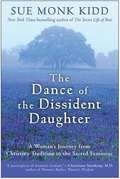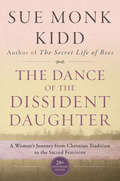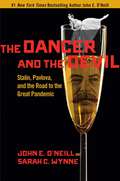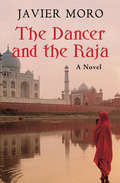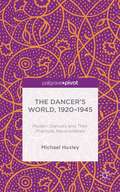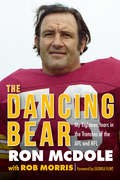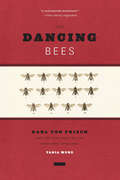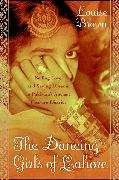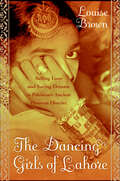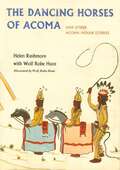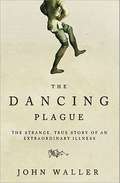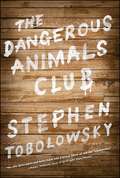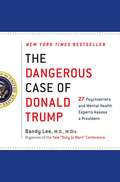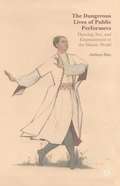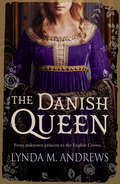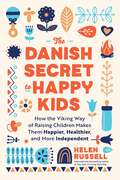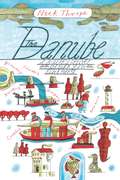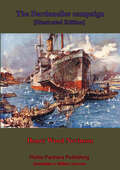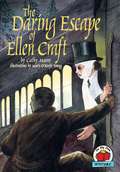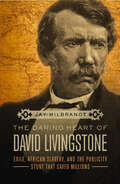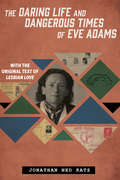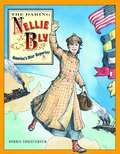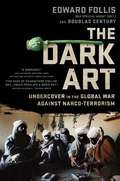- Table View
- List View
The Dance of the Dissident Daughter: A Woman's Journey from Christian Tradition to the Sacred Feminine
by Sue Monk KiddThis is a wonderful story of Kidd's discovery of her self worth and the long history of women and spirituality. Though she addresses difficult issues, she maintains her faith and her marriage, strengthening both by strengthening herself and her understanding of the sacred feminine.
The Dance of the Dissident Daughter: A Woman's Journey from Christian Tradition to the Sacred Feminine
by Sue Monk Kidd"A masterpiece of women's wisdom."--Christiane Northrup, M.D. "The journey to capture her feminine soul and live authentically . . . makes a fascinating, well-researched and well-written story."--Publishers WeeklyIn celebration of the twentieth anniversary of its publication, a newly reissued edition of the bestselling author's classic work of feminine spiritual discovery, with a new introduction by the author."I was amazed to find that I had no idea how to unfold my spiritual life in a feminine way. I was surprised, and, in fact, a little terrified, when I found myself in the middle of a feminist spiritual reawakening."--Sue Monk KiddFor years, Sue Monk Kidd was a conventionally religious woman. Then, in the late 1980s, she experienced an unexpected awakening, and began a journey toward a feminine spirituality. With the exceptional storytelling skills that have helped make her name, Kidd tells her very personal story of the fear, anger, healing, and freedom she experienced on the path toward the wholeness that many women have lost in the church. From a jarring encounter with sexism in a suburban drugstore, to monastery retreats and to rituals in the caves of Crete, she reveals a new level of feminine spiritual consciousness for all women--one that retains a meaningful connection with the "deep song of Christianity," embraces the sacredness of ordinary women's experience, and has the power to transform in the most positive ways every fundamental relationship in a woman's life--her marriage, her career, and her religion.
The Dancer and the Devil: Stalin, Pavlova, and the Road to the Great Pandemic
by John E. O'Neill Sarah C. WynneCommunism must kill what it cannot control. So for a century, it has killed artists, writers, musicians, and even dancers. It kills them secretly, using bioweapons and poison to escape accountability. Among its victims was Anna Pavlova, history&’s greatest dancer, who was said to have God-given wings and feet that never touched the ground. But she defied Stalin, and for that she had to die. Her sudden death in Paris in 1931 was a mystery until now. The Dancer and the Devil traces Marxism&’s century-long fascination with bioweapons, from the Soviets&’ leak of pneumonic plague in 1939 that nearly killed Stalin to leaks of anthrax at Kiev in 1972 and Yekaterinburg in 1979; from the leak of a flu in northeast China in 1977 that killed millions to the catastrophic COVID-19 leak from biolabs in Wuhan, China. Marxism&’s dark past must not be a parent to the world&’s dark future. COMMUNIST CHINA PLAYED WITH FIRE AND THE WORLD IS BURNING Nearly ten million people have died so far from the mysterious Covid-19 virus. These dead follow a long line of thousands of other brave souls stretching back nearly a century who also suffered mysterious &“natural&” deaths, including dancers, writers, saints and heroes. These honored dead should not be forgotten by amnesiac government trying to avoid inconvenient truth. The dead and those who remember and loved them deserve answers to two great questions. How? Why? The Dancer and the Devil answers these questions. It tracks a century of Soviet and then Chinese Communist poisons and bioweapons through their development and intentional use on talented artists and heroes like Anna Pavlova, Maxim Gorky, Raoul Wallenberg and Alexis Navalny. It then tracks leaks of bioweapons beginning in Saratov, Russia in 1939 and Soviet Yekaterinburg in 1979 through Chinese leaks concluding in the recent concealed leak of the manufactured bioweapon Covid-19 from the military lab in Wuhan, China. Stalin, Putin, and Xi, perpetrators of these vast crimes against humanity itself, should not be allowed to escape responsibility. This book assembles the facts on these cowardly murderers, calling them to account for their heartless crimes against man concluding in Covid-19.
The Dancer and the Raja
by Javier MoroA fascinating novel that transports us to the fabulous world of the maharajas--abundant with harems, bacchanalian orgies, jewels, palaces, flamenco music, horses, Rolls-Royces, and tiger hunting On January 28, 1908, a young Spanish woman sitting astride a luxuriously bejeweled elephant enters a small city in northern India. The streets are packed with curious locals who are anxious to pay homage to their new princess, with skin as white as the snows of the Himalayas. This is the beginning of the story, based on real events, of the wedding of Anita Delgado and the maharaja of Kapurthala, a grand story of love and betrayal that took place over almost two decades, in the heart of an India that was on the verge of disappearing.
The Dancer’s World, 1920–1945: Modern Dancers and Their Practices Reconsidered
by Michael HuxleyThe Dancer's World 1920-1945 focuses on modern dancers as they saw themselves. Five chapters describe a narrative arc that encompasses Europe and the USA with a focus between 1920 and 1945. A final chapter considers contemporary relevance for dancers, dance artists, choreographers, dance students and scholars alike.
The Dancing Bear: My Eighteen Years in the Trenches of the AFL and NFL
by Ron McDole Rob Morris George FlintFrom the early sixties to the late seventies, defensive end Ron McDole experienced football’s golden age from inside his old‑school, two‑bar helmet. During an eighteen‑year pro career, McDole—nicknamed “The Dancing Bear”—played in over 250 games, including two AFL Championships with the Buffalo Bills and one NFL Championship with the Washington Redskins. A cagey and deceptively agile athlete, McDole wreaked havoc on football’s best offenses as part of a Bills defensive line that held opponents without a rushing touchdown for seventeen straight games. His twelve interceptions remain a pro record for defensive ends. Traded by the Bills in 1970, he was given new life in Washington as one of the most famous members of George Allen’s game‑smart veterans known as “The Over‑the‑Hill Gang.” Through it all, McDole was known and loved by teammates and foes alike for his knowledge and skill on the field and his ability to have fun off it. In The Dancing Bear McDole the storyteller traces his life from his humble beginnings in Toledo, Ohio, to his four years at the University of Nebraska, his marriage to high school sweetheart Paula, and his long, accomplished professional career. He recounts the days when a pro football player needed an off‑season job to pay the bills and teams had to drive around in buses to find a city park in which to practice. The old AFL and NFL blitz back to life through McDole’s straightforward stories of time when the game was played more for love and glory than for money.
The Dancing Bees: Karl von Frisch and the Discovery of the Honeybee Language
by Tania MunzWe think of bees as being among the busiest workers in the garden, admiring them for their productivity. But amid their buzzing, they are also great communicators--and unusual dancers. As Karl von Frisch (1886-1982) discovered during World War II, bees communicate the location of food sources to each other through complex circle and waggle dances. For centuries, beekeepers had observed these curious movements in hives, and others had speculated about the possibility of a bee language used to manage the work of the hive. But it took von Frisch to determine that the bees' dances communicated precise information about the distance and direction of food sources. As Tania Munz shows in this exploration of von Frisch's life and research, this important discovery came amid the tense circumstances of the Third Reich. The Dancing Bees draws on previously unexplored archival sources in order to reveal von Frisch's full story, including how the Nazi government in 1940 determined that he was one-quarter Jewish, revoked his teaching privileges, and sought to prevent him from working altogether until circumstances intervened. In the 1940s, bee populations throughout Europe were facing the devastating effects of a plague (just as they are today), and because the bees were essential to the pollination of crops, von Frisch's research was deemed critical to maintaining the food supply of a nation at war. The bees, as von Frisch put it years later, saved his life. Munz not only explores von Frisch's complicated career in the Third Reich, she looks closely at the legacy of his work and the later debates about the significance of the bee language and the science of animal communication. This first in-depth biography of von Frisch paints a complex and nuanced portrait of a scientist at work under Nazi rule. The Dancing Bees will be welcomed by anyone seeking to better understand not only this chapter of the history of science but also the peculiar waggles of our garden visitors.
The Dancing Girls of Lahore: Selling Love and Hoarding Dreams in Pakistan's Ancient Pleasure District
by Louise BrownThe dancing girls of Lahore inhabit the Diamond Market in the shadow of a great mosque. The twenty-first century goes on outside the walls of this ancient quarter but scarcely registers within. Though their trade can be described with accuracy as prostitution, the dancing girls have an illustrious history: Beloved by emperors and nawabs, their sophisticated art encompassed the best of Mughal culture. The modern-day Bollywood aesthetic, with its love of gaudy spectacle, music, and dance, is their distant legacy. But the life of the pampered courtesan is not the one now being lived by Maha and her three girls. What they do is forbidden by Islam, though tolerated; but they are gandi, "unclean," and Maha's daughters, like her, are born into the business and will not leave it. Sociologist Louise Brown spent four years in the most intimate study of the family life of a Lahori dancing girl. With beautiful understatement, she turns a novelist's eye on a true story that beggars the imagination. Maha, a classically trained dancer of exquisite grace, had her virginity sold to a powerful Arab sheikh at the age of twelve; when her own daughter Nena comes of age and Maha cannot bring in the money she once did, she faces a terrible decision as the agents of the sheikh come calling once more.
The Dancing Girls of Lahore: Selling Love and Saving Dreams in Pakistan's Pleasure District
by Louise BrownAn unforgettable and compassionate look at the lives of the residents of Lahore’s pleasure districtThe Dancing Girls of Lahore inhabit the Diamond District in the shadow of a great mosque. The 21st century goes on outside the walls, this ancient quarter, but scarcely registers within. Though their trade can be described with accuracy as prostitution, the dancing girls have an illustrious history: beloved by sultans, their sophisticated art encompassed the best of Mughal culture. The modern day Bollywood aesthetic, with its love of gaudy spectacle, music, and dance, is their distant legacy. But the life of the pampered courtesan is not the one now being lived by Maha and her three girls. What they do is forbidden by Islam, though tolerated; but they are, unclean, and Maha’s daughters, like her, are born into the business and will not leave it. Sociologist Louise Brown spent four years in the most intimate study of the family life of one Lahori courtesan. Beautifully understated, it turns a novelist’s eye on a true story that beggars the imagination. Maha, at fourteen a classically trained dancer of exquisite grace, had her virginity sold to the Sultan of Dubai; when her own daughter Nena comes of age and Maha cannot bring in the money she once did, she faces a terrible decision as the agents of the Sultan come calling once more.
The Dancing Horses of Acoma, And Other Acoma Indian Stories
by Wolf Robe HuntThe Dancing Horses of Acoma, and Other Acoma Indian Stories by Wolf Robe Hunt and Helen Rushmore is a captivating collection of tales that bring to life the rich cultural heritage and storytelling traditions of the Acoma Pueblo. Drawing from Native American folklore, history, and legend, this book offers readers a glimpse into the timeless wisdom, creativity, and spirituality of the Acoma people.The centerpiece of the collection, The Dancing Horses of Acoma, tells the enchanting story of magical horses whose extraordinary movements and grace capture the hearts of those who witness them. Alongside this tale are other stories that explore themes of community, respect for nature, and the interplay between the human and spiritual worlds.Each story is told with vivid imagery and a deep respect for the cultural origins of the narratives, reflecting the values and traditions of the Acoma Pueblo. From heroic deeds and mystical encounters to moral lessons and everyday life, the collection celebrates the vibrancy and resilience of Native American storytelling.Accompanied by evocative illustrations, this book is a treasure for readers of all ages who are interested in Indigenous cultures, folklore, and the power of storytelling. The Dancing Horses of Acoma, and Other Acoma Indian Stories is both a tribute to the Acoma people and an invitation to explore the enduring legacy of their oral traditions.
The Dancing Plague
by John WallerA gripping tale of one of history's most bizarre events, and what it reveals about the strange possibilities of human nature In the searing July heat of 1518, Frau Troffea stepped into the streets of Strasbourg and began to dance. Bathed in sweat, she continued to dance. Overcome with exhaustion, she stopped, and then resumed her solitary jig a few hours later. Over the next two months, roughly four hundred people succumbed to the same agonizing compulsion. At its peak, the epidemic claimed the lives of fifteen men, women, and children a day. Possibly 100 people danced to their deaths in one of the most bizarre and terrifying plagues in history. John Waller compellingly evokes the sights, sounds, and aromas; the diseases and hardships; the fervent supernaturalism and the desperate hedonism of the late medieval world. Based on new evidence, he explains why the plague occurred and how it came to an end. In doing so, he sheds light on the strangest capabilities of the human mind and on our own susceptibility to mass hysteria.
The Dangerous Animals Club
by Stephen TobolowskyIf you ran into Stephen Tobolowsky on the street, you would not be mistaken: Yes, you've seen him before. A childhood dentist? A former geometry teacher? Your local florist? Tobolowsky is a character actor, one of the most prolific screen and stage presences of our time, having appeared in productions that range from Deadwood to Glee, from Mississippi Burning to Groundhog Day. But Stephen Tobolowsky, it turns out, is not just an actor; he is also a dazzlingly talented storyteller and writer. He has earned a devoted base of fans for his original stories, told in front of live audiences as well as in a popular podcast. Now, for the first time, he has assembled those stories here. The result is creative mitzvah, a work of art, and a narrative feat that combines biography and essay, ranging in tone from the hilarious to the introspective. To read these pages is to enter an astonishing world that, like all art, is universal yet individual, familiar yet disquieting. A dangerous world, indeed.
The Dangerous Case of Donald Trump: Based on the Yale Conference, Two Dozen Mental Health Experts Assess a President
by Bandy X. LeeThe New York Times bestseller! More than two dozen psychiatrists and psychologists offer their consensus view that Trump's mental state presents a clear and present danger to our nation and individual well-being. This is not normal. Since the start of Donald Trump's presidential run, one question has quietly but urgently permeated the observations of concerned citizens: What is wrong with him? Constrained by the American Psychiatric Association's "Goldwater rule," which inhibits mental health professionals from diagnosing public figures they have not personally examined, many of those qualified to answer this question have shied away from discussing the issue at all. The public has thus been left to wonder whether he is mad, bad, or both. In THE DANGEROUS CASE OF DONALD TRUMP, twenty-seven psychiatrists, psychologists, and other mental health experts argue that, in Mr. Trump's case, their moral and civic "duty to warn" America supersedes professional neutrality. They then explore Trump's symptoms and potentially relevant diagnoses to find a complex, if also dangerously mad, man. Philip Zimbardo and Rosemary Sword, for instance, explain Trump's impulsivity in terms of "unbridled and extreme present hedonism. " Craig Malkin writes on pathological narcissism and politics as a lethal mix. Gail Sheehy, on a lack of trust that exceeds paranoia. Lance Dodes, on sociopathy. Robert Jay Lifton, on the "malignant normality" that can set in everyday life if psychiatrists do not speak up. His madness is catching, too. From the trauma people have experienced under the Trump administration to the cult-like characteristics of his followers, he has created unprecedented mental health consequences across our nation and beyond. It's not all in our heads. It's in his. "There will not be a book published this fall more urgent, important, or controversial than The Dangerous Case of Donald Trump. . . profound, illuminating and discomforting" --Bill Moyers
The Dangerous Lives of Public Performers
by Anthony ShayExamining performers from the ancient Mediterranean world to the modern Islamic Middle East, including India and Pakistan, Shay explores the careers, artistic performances, and legacies of these individuals who were forced to produce entertainment and art for, and have sex with, any and all patrons.
The Danish Queen
by Lynda M. AndrewsFrom &“an outstanding storyteller,&” a historical novel about a Danish princess who became the Queen of Great Britain (Woman&’s Weekly). Anne of Holstein is perhaps the least-known Queen Consort in Britain&’s history. But her marriage to James I saw her become key to the legacy of the Stuarts. From her homeland of Denmark, Anne travelled to Scotland—a place she had heard tales about of ruthless and bloodthirsty people—and met her betrothed. A teenage Anne was infatuated with her match. They married and bore children, but as the Princess grew to womanhood in the turbulent court of Scotland, she was subject to the unpredictable behaviour of her husband. When Queen Elizabeth I died, James inherited the crown of England and was the first ruler to call himself &‘King of Great Britain&’, and Anne the first queen. The Danish Queen tells the story of a woman who crossed the sea and found love and power, but was fated to watch the heartbreaking demise of her children, all of whom were to be haunted by the tragic destiny of the Stuarts. It is a dramatic and enlightening account of the early years and marriage of a queen whose place in history is little known, and is perfect for fans of Anne O&’Brien, Elizabeth Chadwick and Alison Weir.
The Danish Secret to Happy Kids: How the Viking Way of Raising Children Makes Them Happier, Healthier, and More Independent
by Helen Russell"Smart, witty and packed with surprising facts about life in the Nordics, The Danish Secret to Happy Kids is a foolproof roadmap to raising kids the Viking way. If you enjoy Helen Russell's signature self-deprecating sense of humor and captivating storytelling, you're in for a real treat." —Linda Åkeson McGurk, author of There's No Such Thing as Bad Weather and The Open-Air LifeWhat do Vikings know about raising children? Turns out, quite a bit. After a decade of living in Denmark, and raising her three kids there, Helen Russell noticed that Nordic kids (or mini-Vikings) are different from children raised in other parts of the world. They eat differently. They learn differently. They play, dress, and even sleep differently. They run, jump, climb, fall and get up again, out in nature, for hours a day. It's cold and wet and uncomfortable—often. But they cope. Even though the weather's terrible and it's dark October through March. And then they grow up to be some of the happiest adults on the planet. So her question was: how?In The Danish Secret to Happy Kids, Russell dives deep into the parenting culture of Denmark and the other Nordic nations, from parental leave policies to school structure to screen time, uncovering surprising strategies and customs that lead to largely happy, well-adjusted humans over the long term. This fascinating peek behind the cultural curtain allows readers to marvel over infants comfortably sleeping outside in chilly temperatures, school-age kids wielding axes in the woods, and teenagers spending a year or two at efterskole, a special boarding school designed to prepare adolescents for independent life in the real world—a concept that is beginning to be adopted in other nations.Refreshingly funny and unfailingly optimistic about the new generation of humans growing up in the world right now, The Danish Secret to Happy Kids is a heart-warming love letter to Russell's adopted homeland, a comforting armchair travel read, and proof that we could all use a bit more Viking in our everyday lives.
The Danube
by Nick Thorpehopkeepers, beekeepers, waitresses, smugglers and border policemen, legal and illegal immigrants, and many more. For readers who anticipate their own journeys on the Danube, as well as those who only dream of seeing the great river, this book will be a unique and treasured guide.
The Dardanelles Campaign [Illustrated Edition]
by Henry Wood NevinsonHenry Wood Nevinson, surely thought that he had seen everything that war could throw up; as a seasoned war correspondent, he had followed the British forces in many campaigns including the second Boer War where he was stranded in Ladysmith during the siege. However his experiences during the First World War would shock him, he travelled to France and witnessed the initial clashes of the War. He then accompanied the troops to Gallipoli, being wounded in the process of his reporting. His experiences in the Peninsula would form the basis of this book.His account of the Dardanelles campaign covers all of the action from the initial planning stages on the Admiralty's drawing boards, through the naval attacks to the landings and the struggle amongst the deadly rocks and beaches of Gallipoli. Nevinson was careful to check and re-check his information, using numerous illustrations and staff maps for accuracy. It is clearly one of the best eye-witness written campaign studies of the terrible struggles of 1915 on the shores of Turkey.Highly recommended.Author -- Nevinson, Henry Wood, 1856-1941.Text taken, whole and complete, from the edition published in New York, H. Holt & co., 1919.Original Page Count - xx and 427 pages.Illustrations -- 16 maps and Illustrations
The Daredevil Of The Army; Experiences As A “Buzzer” And Despatch Rider [Illustrated Edition]
by Captain Austin Patrick CorcoranIncludes the First World War Illustrations Pack - 73 battle plans and diagrams and 198 photos"A bikers war-compellingly recounted"The highly dangerous task of the aide-de-camp was often to carry urgent despatches with essential calls to action across the field of battle. The young men chosen for the job were invariably dashing, brave and prepared to take risks to achieve their objectives. They were, of course, always expert horsemen. The age of the military horseman had not quite come to a close at the time of the First World War, but-as with most forms of progress-he was sharing duties with that which would eventually replace him, the machines of the new age. Now there was a another breed of 'daredevil,' though necessarily 'cut from the same cloth.' The motorcycle despatch riders were a new service created in an age of innovation. All were so called 'amateur' soldiers though immediately at least ranked corporal so that they could, by British Army convention, address officers directly. These were invariably intelligent, accomplished young men drawn from the professions or universities. Their creed was the same as that of their horse mounted predecessors-the messages they carried had to get through and to deliver them motorcyclists often had to outpace charging Uhlans. Many of them ended their careers tangled among the wreckage of their 'bikes.' The author of this book has written a thrilling first hand account of his experiences riding military motorcycles along the front lines during the early stages of the First World War. Later as an officer he took command of a unit of 'buzzers,' whose job it was to maintain telephone links. A highly entertaining book and thoroughly recommended to all those interested in motorcycles, motorcycling and the Great War in Europe."-Print ed.
The Daring Escape of Ellen Craft (On My Own History)
by Cathy MooreOn December 21, 1848, Ellen Craft and her husband, William, slipped out into the cold, dark night and took their first steps towards freedom. They were runaway slaves. Posing as a white man traveling with a slave, Ellen courageously boarded a train bound for Philadelphia. Could they actually make it a thousand miles without being discovered? As each tension-filled day passed and freedom got closer, Ellen and William risked everything - even death - to be free.
The Daring Heart of David Livingstone: Exile, African Slavery, and the Publicity Stunt That Saved Millions
by Jay MilbrandtThe captivating, untold story of the great explorer, David Livingstone: his abiding faith and his heroic efforts to end the African slave tradeSaint? Missionary? Scientist? Explorer?The titles given to David Livingstone since his death are varied enough to seem dubious—and with good reason. In view of the confessions in his own journals, saint is out of the question. Even missionary is tenuous, considering he made only one convert. And despite his fame as a scientist and explorer, Livingstone left his most indelible mark on Africa in an arena few have previously examined: slavery.His impact on abolishing what he called “this awful slave-trade” has been shockingly overlooked as the centerpiece of his African mission.Until now.The Daring Heart of David Livingstone tells his story from the beginning of his time in Africa to the publicity stunt that saved millions after his death.
The Daring Life and Dangerous Times of Eve Adams
by Jonathan Ned KatzEve Adams was a rebel. Born Chawa Zloczewer into a Jewish family in Poland, Adams emigrated to the United States in 1912. The young woman befriended anarchists, sold radical publications, took a new name, and ran lesbian-and-gay-friendly speakeasies in Chicago and New York. Then, in 1925, Adams risked all to write and publish a book titled Lesbian Love. In a repressive era, long before today's gay liberation movement, when American women had just gained the right to vote, Adams's bold activism caught the attention of the young J. Edgar Hoover and the US Bureau of Investigation, leading to her surveillance and arrest. In a case that pitted immigration officials, the New York City police, and a biased informer against her, Adams was convicted of publishing an obscene book and of attempted sex with a policewoman sent to entrap her. Adams was jailed and then deported back to Europe, and ultimately murdered by Nazis in Auschwitz. In Sex Rebel: The Daring Life and Deadly Times of Eve Adams, acclaimed historian Jonathan Ned Katz has recovered the extraordinary story of an early, daring activist. Drawing on startling evidence, carefully distinguishing fact from fiction, Katz presents the first biography of Adams, and the publisher reprints the long-lost text of Adams's rare, unique book Lesbian Love.
The Daring Nellie Bly: America's Star Reporter
by Bonnie ChristensenFrom the award-winning picture book biographer of Woody Guthrie comes the inspirational story of Nellie Bly. Born in 1864, during a time in which options were extremely limited for women, Nellie defied all expectations and became a famous newspaper correspondent. Her daring exploits included committing herself to an infamous insane asylum in New York City to expose the terrible conditions there and becoming the first American war correspondent of either sex to report on the front lines of Austria during World War I. In 1889, Nellie completed her most publicized stunt, her world-famous trip around the world in just 72 days, beating the record of Jules Vernes’ fictional hero inAround the World in 80 Days. With an informative text and pen-and-ink illustrations reminiscent of the graphic style of the late 1800s,The Daring Nellie Blycaptures the independent spirit of America’s first star reporter, Nellie Bly. From the Hardcover edition.
The Dark Art
by Douglas Century Edward FollisA highly decorated veteran DEA agent recounts his incredible undercover career and reveals the shocking links between narcotics trafficking and terrorismWhat exactly is undercover? From a law-enforcement perspective, undercover is the art of skillfully eliciting incriminating statements. From a personal and psychological standpoint, it's the dark art of gaining trust--then manipulating that trust. In the simplest terms, it's playing a chess game with the bad guy, getting him to make the moves you want him to make--but without him knowing you're doing so. Edward Follis mastered the chess game--The Dark Art--over the course of his distinguished twenty-seven years with the Drug Enforcement Administration, where he bought eightballs of coke in a red Corvette, negotiated multimillion-dollar deals onboard private King Airs, and developed covert relationships with men who were not only international drug-traffickers but--in some cases--operatives for Al Qaeda, Hezbollah, Hamas, the Shan United Army, or the Mexican federation of cartels.Follis was, in fact, one of the driving forces behind the agency's radical shift from a limited local focus to a global arena. In the early nineties, the DEA was primarily known for doing street-level busts evocative of Miami Vice. Today, it uses high-resolution-optics surveillance and classified cutting-edge technology to put the worst narco-terror kingpins on the business end of "stealth justice" delivered via Predator drone pilots.Spanning five continents and filled with harrowing stories about the world's most ruthless drug lords and terrorist networks, Follis's memoir reads like a thriller. Yet every word is true, and every story is documented. Follis earned a Medal of Valor for his work, and coauthor Douglas Century is a pro at shaping and telling just this kind of story. The first and only insider's account of the confluence between narco-trafficking and terrorist organizations, The Dark Art is a page-turning memoir that will electrify you from page one.
The Dark Art
by Douglas Century Edward FollisA highly decorated veteran DEA agent recounts his incredible undercover career and reveals the shocking links between narcotics trafficking and terrorismWhat exactly is undercover? From a law-enforcement perspective, undercover is the art of skillfully eliciting incriminating statements. From a personal and psychological standpoint, it's the dark art of gaining trust--then manipulating that trust. In the simplest terms, it's playing a chess game with the bad guy, getting him to make the moves you want him to make--but without him knowing you're doing so. Edward Follis mastered the chess game--The Dark Art--over the course of his distinguished twenty-seven years with the Drug Enforcement Administration, where he bought eightballs of coke in a red Corvette, negotiated multimillion-dollar deals onboard private King Airs, and developed covert relationships with men who were not only international drug-traffickers but--in some cases--operatives for Al Qaeda, Hezbollah, Hamas, the Shan United Army, or the Mexican federation of cartels.Follis was, in fact, one of the driving forces behind the agency's radical shift from a limited local focus to a global arena. In the early nineties, the DEA was primarily known for doing street-level busts evocative of Miami Vice. Today, it uses high-resolution-optics surveillance and classified cutting-edge technology to put the worst narco-terror kingpins on the business end of "stealth justice" delivered via Predator drone pilots.Spanning five continents and filled with harrowing stories about the world's most ruthless drug lords and terrorist networks, Follis's memoir reads like a thriller. Yet every word is true, and every story is documented. Follis earned a Medal of Valor for his work, and coauthor Douglas Century is a pro at shaping and telling just this kind of story. The first and only insider's account of the confluence between narco-trafficking and terrorist organizations, The Dark Art is a page-turning memoir that will electrify you from page one.
